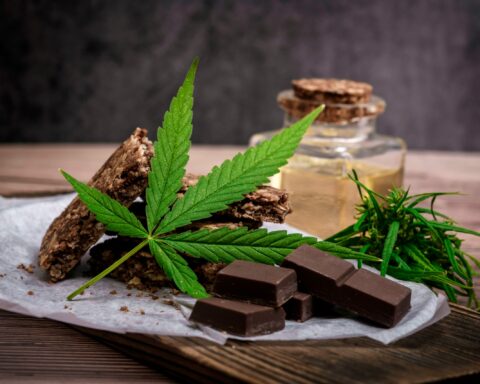You have perhaps observed that cannabis consumers have bloodshot eyes. This unique appearance is related to smoking weed, but what about taking something different? Currently, cannabis products are available in various sizes, shapes, and forms. Cannabis plants contain two compounds, including cannabidiol (CBD) and delta-9 tetrahydrocannabinol (THC). The two compounds have brought misconceptions, especially on their effects. Experts explain that THC causes psychoactive and euphoric effects, whereas CBD does not. This implies that CBD and THC consumers will have different experiences. CBD comes in distinct formulations like edibles, oils, and tinctures. CBD edibles are edible foodstuffs infused with cannabidiol. This blog discusses whether taking these edibles cause eye reddening.
What is CBD?
Cannabidiol is among the major cannabinoid compounds in the cannabis plant. Different cannabis varieties have varying amounts of cannabidiol (CBD). For instance, in potent, tetrahydrocannabinol-heavy varieties, cannabidiol might be found in small quantities in high-cannabidiol strains. Nevertheless, such strain contributes about 20 percent or higher dry weight plant amounts. Cannabidiol’s chemical structure resembles that of tetrahydrocannabinol. CBD has an additional oxygen and hydrogen combination, thus differing from THC. This subtle distinction empowers cannabidiol to function without interrupting cognitive processes. Many accounts identify cannabidiol as friendly to utilize in various formulations. Recently, the World Health Organization (WHO) reported that cannabidiol has no effects showing dependence or abuse potential. In addition, taking pure CBD does not cause any public health-linked problems.
CBD and Red Eyes
Theoretical evidence shows that cannabis exhibits the potential of easing some medical symptoms and conditions. However, cannabis significantly differs in chemical profile. In regard to body effects, CBD and THC are considered compounds that influence human physiology. Considering red eyes, THC appears to be the overall culprit. When tetrahydrocannabinol penetrates the body, it de-escalates blood pressure and thus widens blood vessels, including those behind the eyes. When these blood vessels enlarge, blood movement toward the eyes spikes significantly. This assists in decreasing accumulated pressure. For this reason, high-tetrahydrocannabinol cannabis is utilized in glaucoma.
Similarly, products such as high-THC oils and edibles will generate corresponding red eyes. Unfortunately, the elevated blood flow causes watery, puffy, irritated, red-looking eyes that resemble marijuana proponents over generations. Cannabidiol does not generate similar effects, meaning that it does not cause bloodshot eyes. However, CBD consumers might encounter watery eyes resulting from reacting with smoke or different allergens. Notably, eye irritation cannot be caused by CBD solely.
How CBD Works
The body should maintain homeostasis processes like movement, memory, mood, and temperature in balance. In this regard, the endocannabinoid system (ECS) plays an important role in accomplishing this endeavor. This system is copious in both central and peripheral nervous systems. The Endocannabinoid system contains a mesh of endocannabinoids and receptors, body-generated cannabinoids. Phytocannabinoids are cannabinoids naturally occurring in cannabis plants, such as cannabidiol and tetrahydrocannabinol. Although THC directly attaches to endocannabinoid receptors, thus galvanizing cognitive fluctuations, cannabidiol functions in an indirect method. In this regard, cannabidiol does not attach directly with receptors but influences many receptor-based channels and ion pathways to generate multiple beneficial effects. Notably, the widening of blood vessels is excluded from the above effects. Conclusively, this discussion disregards that CBD causes bloodshot eyes.
The Legality of CBD
In 2018, CBD succeeded in the United States Farm Bill, so people knew that it had been fully authorized. This is because this bill legalized hemp, a cannabis strain that contains minimal THC and high CBD amounts. The meticulous legal implications regarding CBD utilization under the U.S Farm Bill are more complex than these general assumptions. Hemp-extracted cannabidiol products are broadly available in uttermost regions of the U.S, including states with no medicinal cannabis programs. Since they have no intoxicating effects, users utilize cannabidiol extracts for their possible therapeutic benefits instead of recreational substances.A study by Suraev, et al.(2020)., has shown that CBD can address sleep disorders, pain, and anxiety. The Food and Drug Administration (FDA) confirmed Epidiolex, the only CBD-related prescription utilized in diagnosing epilepsy. However, marijuana falls in schedule one substance in the United States of America. The federal law determines its possession and application, although some states legalized it perhaps in various formulations. For instance, certain states authorize only medical marijuana utilization, whereas others recreational use. Consumers should abide by their laws for proper and legal utilization of CBD products.
Should Consumers Worry about Cannabidiol Edibles Causing Bloodshot Eyes?
Many experts consider bloodshot eyes after edible ingestion to be faultlessly normal. In case an individual experiences irritation after taking cannabis, the experts advise them to buy drops to relieve the eyes. Alternatively, they can wash their faces with cold water since it assists blood vessels in contract to regain their normal size. By doing so, the red eyes will disappear. Nonetheless, edible-induced redness persists longer than other cannabis administration methods. People ingest edibles in huge amounts, and THC delays penetrate your body via the gut wall. Usually, redness increases between 2-3 hours after taking cannabis. Then, this redness will persist for 4-12 hours, depending on the body’s ability to acquire its baseline. In case you are concerned about bloodshot eyes, eliminate THC-dominant edible products. Currently, most suppliers manufacture CBD-dominant edible products that are void of these effects. Alternatively, try making edibles with your daily food. Some studies show that taking cannabis with different foods lowers the severity of eye redness.
Are Bloodshot Eyes Unhealthy for Consumers?
Red eyes are sometimes painful and unsightly, although they do not endanger one’s health. Bloodshot eyes are safe, provided they are not interfering with your activities. However, seek medical attention if the problem persists for long.
Conclusion
Cannabis plants contain CBD and THC compounds which have different body effects. THC shows psychoactive and euphoric effects while CBD does not. Cannabis products come in various formulations, including edibles, tinctures, and oils. In addition, there are CBD and THC dominant products. For instance, THC-infused edibles cause eye reddening due to THC contents, while CBD-infused edibles have no effect. This is because CBD and THC interact with the endocannabinoid system uniquely. In this regard, THC attaches endocannabinoids directly while CBD indirectly. THC dilates all blood vessels, causing higher blood flow, which turns their eyes red. As established, CBD edibles are safe for use without being concerned about eye reddening.
References
Suraev, A. S., Marshall, N. S., Vandrey, R., Mccartney, D., Benson, M. J., Mcgregor, I. S., … & Hoyos, C. M. (2020). Cannabinoid Therapies In The Management Of Sleep Disorders: A Systematic Review Of Preclinical And Clinical Studies. Sleep Medicine Reviews, 53, 101339
- Eye Spy: Worldwide Eye Color Percentages - April 19, 2024
- Elevate Energy, Soothe Stress, And Peak Performance with The New UNBEETABREW Coffee Sensation - September 21, 2023
- Chef Bob’s Coffee: A Journey Fueled by Passion - July 29, 2023









